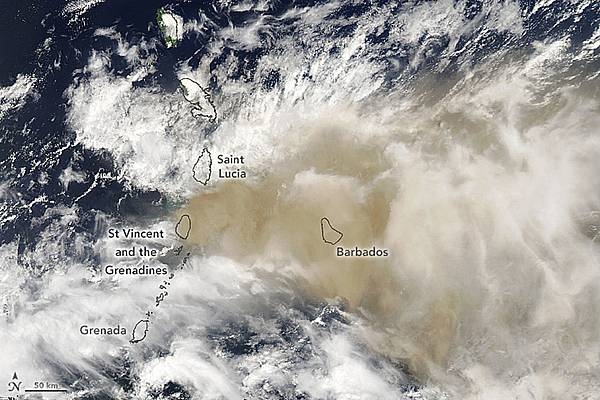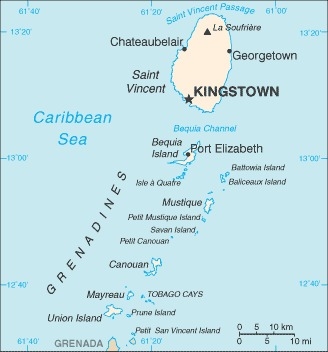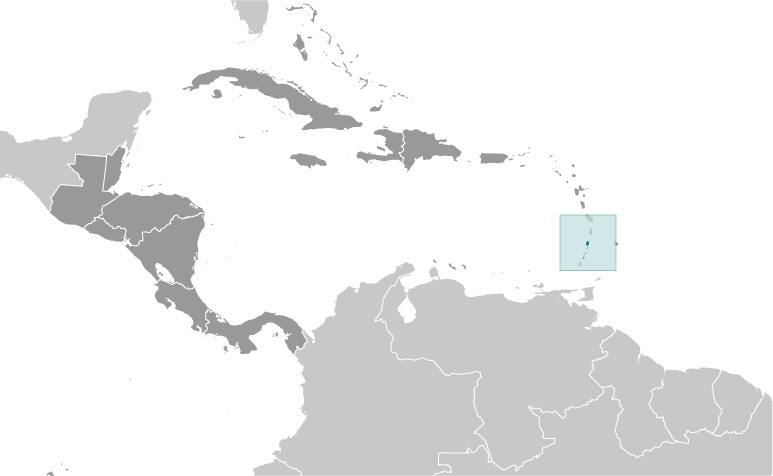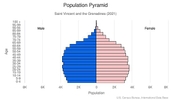Saint Vincent and the Grenadines
Introduction
Background
Resistance by native Caribs prevented colonization on Saint Vincent until 1719. Disputed between France and the UK for most of the 18th century, the island was ceded to the latter in 1783. The British prized Saint Vincent due to its fertile soil, which allowed for thriving slave-run plantations of sugar, coffee, indigo, tobacco, cotton, and cocoa. In 1834, the British abolished slavery. Immigration of indentured servants eased the ensuing labor shortage, as did subsequent Portuguese immigrants from Madeira and East Indian laborers. Conditions remained harsh for both former slaves and immigrant agricultural workers, however, as depressed world sugar prices kept the economy stagnant until the early 1900s. The economy then went into a period of decline with many landowners abandoning their estates and leaving the land to be cultivated by liberated slaves. Between 1960 and 1962, Saint Vincent and the Grenadines was a separate administrative unit of the Federation of the West Indies. Autonomy was granted in 1969 and independence in 1979.
Visit the Definitions and Notes page to view a description of each topic.
Geography
Location
Caribbean, islands between the Caribbean Sea and North Atlantic Ocean, north of Trinidad and Tobago
Geographic coordinates
13 15 N, 61 12 W
Map references
Central America and the Caribbean
Area
total: 389 sq km (Saint Vincent 344 sq km)
land: 389 sq km
water: 0 sq km
Land boundaries
total: 0 km
Coastline
84 km
Maritime claims
territorial sea: 12 nm
contiguous zone: 24 nm
exclusive economic zone: 200 nm
continental shelf: 200 nm
Climate
tropical; little seasonal temperature variation; rainy season (May to November)
Terrain
volcanic, mountainous
Elevation
highest point: La Soufriere 1,234 m
lowest point: Caribbean Sea 0 m
Natural resources
hydropower, arable land
Land use
agricultural land: 25.6% (2018 est.)
arable land: 12.8% (2018 est.)
permanent crops: 7.7% (2018 est.)
permanent pasture: 5.1% (2018 est.)
forest: 68.7% (2018 est.)
other: 5.7% (2018 est.)
Irrigated land
10 sq km (2012)
Population distribution
most of the population is concentrated in and around the capital of Kingstown
Natural hazards
hurricanes; La Soufriere volcano on the island of Saint Vincent is a constant threat
volcanism: La Soufriere (1,234 m) on the island of Saint Vincent last erupted in 1979; the island of Saint Vincent is part of the volcanic island arc of the Lesser Antilles that extends from Saba in the north to Grenada in the south
Geography - note
the administration of the islands of the Grenadines group is divided between Saint Vincent and the Grenadines and Grenada; Saint Vincent and the Grenadines is comprised of 32 islands and cays
People and Society
Nationality
noun: Saint Vincentian(s) or Vincentian(s)
adjective: Saint Vincentian or Vincentian
Ethnic groups
African descent 71.2%, mixed 23%, Indigenous 3%, East Indian/Indian 1.1%, European 1.5%, other 0.2% (2012 est.)
Languages
English, Vincentian Creole English, French patois
Religions
Protestant 75% (Pentecostal 27.6%, Anglican 13.9%, Seventh Day Adventist 11.6%, Baptist 8.9%, Methodist 8.7%, Evangelical 3.8%, Salvation Army 0.3%, Presbyterian/Congregational 0.3%), Roman Catholic 6.3%, Rastafarian 1.1%, Jehovah's Witness 0.8%, other 4.7%, none 7.5%, unspecified 4.7% (2012 est.)
Age structure
0-14 years: 20.15% (male 10,309/female 10,121)
15-24 years: 14.83% (male 7,582/female 7,451)
25-54 years: 42.63% (male 22,395/female 20,824)
55-64 years: 11.68% (male 6,136/female 5,703)
65 years and over: 10.72% (male 5,167/female 5,702) (2020 est.)
Dependency ratios
total dependency ratio: 46.7
youth dependency ratio: 32.1
elderly dependency ratio: 14.5
potential support ratio: 6.9 (2020 est.)
Median age
total: 35.3 years
male: 35.4 years
female: 35.1 years (2020 est.)
Population distribution
most of the population is concentrated in and around the capital of Kingstown
Urbanization
urban population: 53.5% of total population (2021)
rate of urbanization: 0.94% annual rate of change (2020-25 est.)
Major urban areas - population
27,000 KINGSTOWN (capital) (2018)
Sex ratio
at birth: 1.03 male(s)/female
0-14 years: 1.02 male(s)/female
15-24 years: 1.02 male(s)/female
25-54 years: 1.08 male(s)/female
55-64 years: 1.08 male(s)/female
65 years and over: 0.91 male(s)/female
total population: 1.04 male(s)/female (2020 est.)
Maternal mortality ratio
98 deaths/100,000 live births (2017 est.)
country comparison to the world: 70Infant mortality rate
total: 13.16 deaths/1,000 live births
male: 14.9 deaths/1,000 live births
female: 11.38 deaths/1,000 live births (2021 est.)
Life expectancy at birth
total population: 76.43 years
male: 74.37 years
female: 78.55 years (2021 est.)
Drinking water source
improved: total: 95.1% of population
unimproved: total: 4.9% of population (2017 est.)
Current Health Expenditure
4.5% (2018)
Physicians density
0.66 physicians/1,000 population
Hospital bed density
4.3 beds/1,000 population (2016)
Sanitation facility access
improved: total: 90.2% of population
unimproved: total: 9.8% of population (2017 est.)
HIV/AIDS - deaths
<100 (2018)
School life expectancy (primary to tertiary education)
total: 14 years
male: 14 years
female: 15 years (2015)
Environment
Environment - current issues
pollution of coastal waters and shorelines from discharges by pleasure yachts and other effluents; in some areas, pollution is severe enough to make swimming prohibitive; poor land use planning; deforestation; watershed management and squatter settlement control
Environment - international agreements
party to: Biodiversity, Climate Change, Climate Change-Kyoto Protocol, Climate Change-Paris Agreement, Comprehensive Nuclear Test Ban, Desertification, Endangered Species, Environmental Modification, Hazardous Wastes, Law of the Sea, Marine Dumping-London Convention, Ozone Layer Protection, Ship Pollution, Whaling
signed, but not ratified: none of the selected agreements
Air pollutants
particulate matter emissions: 21.2 micrograms per cubic meter (2016 est.)
carbon dioxide emissions: 0.22 megatons (2016 est.)
methane emissions: 0.09 megatons (2020 est.)
Climate
tropical; little seasonal temperature variation; rainy season (May to November)
Land use
agricultural land: 25.6% (2018 est.)
arable land: 12.8% (2018 est.)
permanent crops: 7.7% (2018 est.)
permanent pasture: 5.1% (2018 est.)
forest: 68.7% (2018 est.)
other: 5.7% (2018 est.)
Urbanization
urban population: 53.5% of total population (2021)
rate of urbanization: 0.94% annual rate of change (2020-25 est.)
Revenue from forest resources
forest revenues: 0.02% of GDP (2018 est.)
country comparison to the world: 144Waste and recycling
municipal solid waste generated annually: 31,561 tons (2015 est.)
Total water withdrawal
municipal: 8.5 million cubic meters (2017 est.)
industrial: 2,000 cubic meters (2017 est.)
agricultural: 0 cubic meters (2017 est.)
Total renewable water resources
100 million cubic meters (2017 est.)
Government
Country name
conventional long form: none
conventional short form: Saint Vincent and the Grenadines
etymology: Saint Vincent was named by explorer Christopher COLUMBUS after Saint VINCENT of Saragossa because the 22 January 1498 day of discovery was the saint's feast day
Government type
parliamentary democracy under a constitutional monarchy; a Commonwealth realm
Capital
name: Kingstown
geographic coordinates: 13 08 N, 61 13 W
time difference: UTC-4 (1 hour ahead of Washington, DC, during Standard Time)
etymology: an earlier French settlement was renamed Kingstown by the British in 1763 when they assumed control of the island; the king referred to in the name is George III (r. 1760-1820)
Administrative divisions
6 parishes; Charlotte, Grenadines, Saint Andrew, Saint David, Saint George, Saint Patrick
Independence
27 October 1979 (from the UK)
National holiday
Independence Day, 27 October (1979)
Constitution
history: previous 1969, 1975; latest drafted 26 July 1979, effective 27 October 1979 (The Saint Vincent Constitution Order 1979)
amendments: proposed by the House of Assembly; passage requires at least two-thirds majority vote of the Assembly membership and assent of the governor general; passage of amendments to constitutional sections on fundamental rights and freedoms, citizen protections, various government functions and authorities, and constitutional amendment procedures requires approval by the Assembly membership, approval in a referendum of at least two thirds of the votes cast, and assent of the governor general
Legal system
English common law
International law organization participation
has not submitted an ICJ jurisdiction declaration; accepts ICCt jurisdiction
Citizenship
citizenship by birth: yes
citizenship by descent only: at least one parent must be a citizen of Saint Vincent and the Grenadines
dual citizenship recognized: yes
residency requirement for naturalization: 7 years
Suffrage
18 years of age; universal
Executive branch
chief of state: Queen ELIZABETH II (since 6 February 1952); represented by Governor General Susan DOUGAN (since 1 August 2019)
head of government: Prime Minister Ralph E. GONSALVES (since 29 March 2001)
cabinet: Cabinet appointed by the governor general on the advice of the prime minister
elections/appointments: the monarchy is hereditary; governor general appointed by the monarch; following legislative elections, the leader of the majority party usually appointed prime minister by the governor general; deputy prime minister appointed by the governor general on the advice of the prime minister
Legislative branch
description: unicameral House of Assembly (23 seats; 15 representatives directly elected in single-seat constituencies by simple majority vote, 6 senators appointed by the governor general, and 2 ex officio members - the speaker of the house and the attorney general; members serve 5-year terms)
elections: last held on 5 November 2020 (next to be held in 2025)
election results: percent of vote by party - ULP 49.58%, NDP 50.34%, other 0.8%; seats by party - ULP 9, NDP 6
Judicial branch
highest courts: the Eastern Caribbean Supreme Court (ECSC) is the superior court of the Organization of Eastern Caribbean States; the ECSC - headquartered on St. Lucia - consists of the Court of Appeal - headed by the chief justice and 4 judges - and the High Court with 18 judges; the Court of Appeal is itinerant, traveling to member states on a schedule to hear appeals from the High Court and subordinate courts; High Court judges reside in the member states, with 2 assigned to Saint Vincent and the Grenadines; note - Saint Vincent and the Grenadines is also a member of the Caribbean Court of Justice
judge selection and term of office: chief justice of Eastern Caribbean Supreme Court appointed by Her Majesty, Queen ELIZABETH II; other justices and judges appointed by the Judicial and Legal Services Commission, an independent body of judicial officials; Court of Appeal justices appointed for life with mandatory retirement at age 65; High Court judges appointed for life with mandatory retirement at age 62
subordinate courts: magistrates' courts
Political parties and leaders
Democratic Republican Party or DRP [Anesia BAPTISTE]
New Democratic Party or NDP [Godwin L. FRIDAY]
Unity Labor Party or ULP [Dr. Ralph GONSALVES] (formed in 1994 by the coalition of Saint Vincent Labor Party or SVLP and the Movement for National Unity or MNU)
SVG Green Party or SVGP [Ivan O'NEAL]
International organization participation
ACP, AOSIS, C, Caricom, CDB, CELAC, FAO, G-77, IBRD, ICAO, ICCt, ICRM, IDA, IFAD, IFRCS, ILO, IMF, IMO, Interpol, IOC, IOM, ISO (subscriber), ITU, MIGA, NAM, OAS, OECS, OPANAL, OPCW, Petrocaribe, UN, UNCTAD, UNESCO, UNIDO, UPU, WFTU (NGOs), WHO, WIPO, WTO
Diplomatic representation in the US
chief of mission: Ambassador Lou-Anne Gaylene GILCHRIST (since 18 January 2017)
chancery: 1627 K Street, NW, Suite 1202, Washington, DC 20006
telephone: [1] (202) 364-6730
FAX: [1] (202) 364-6730
email address and website:
mail@embsvg.com
http://wa.embassy.gov.vc/washington/
consulate(s) general: New York
Diplomatic representation from the US
embassy: the US does not have an embassy in Saint Vincent and the Grenadines; the US Ambassador to Barbados is accredited to Saint Vincent and the Grenadines
Flag description
three vertical bands of blue (hoist side), gold (double width), and green; the gold band bears three green diamonds arranged in a V pattern, which stands for Vincent; the diamonds recall the islands as "the Gems of the Antilles" and are set slightly lowered in the gold band to reflect the nation's position in the Antilles; blue conveys the colors of a tropical sky and crystal waters, yellow signifies the golden Grenadine sands, and green represents lush vegetation
National symbol(s)
Saint Vincent parrot; national colors: blue, gold, green
National anthem
name: St. Vincent! Land So Beautiful!
lyrics/music: Phyllis Joyce MCCLEAN PUNNETT/Joel Bertram MIGUEL
note: adopted 1967
Economy
Economic overview
Success of the economy hinges upon seasonal variations in agriculture, tourism, and construction activity, as well as remittances. Much of the workforce is employed in banana production and tourism. Saint Vincent and the Grenadines is home to a small offshore banking sector and continues to fully adopt international regulatory standards.
This lower-middle-income country remains vulnerable to natural and external shocks. The economy has shown some signs of recovery due to increased tourist arrivals, falling oil prices and renewed growth in the construction sector. The much anticipated international airport opened in early 2017 with hopes for increased airlift and tourism activity. The government's ability to invest in social programs and respond to external shocks is constrained by its high public debt burden, which was 67% of GDP at the end of 2013.
Real GDP (purchasing power parity)
$1.34 billion note: data are in 2017 dollars (2020 est.)
$1.38 billion note: data are in 2017 dollars (2019 est.)
$1.37 billion note: data are in 2017 dollars (2018 est.)
note: data are in 2017 dollars
Real GDP growth rate
0.7% (2017 est.)
0.8% (2016 est.)
0.8% (2015 est.)
Real GDP per capita
$12,100 note: data are in 2017 dollars (2020 est.)
$12,500 note: data are in 2017 dollars (2019 est.)
$12,500 note: data are in 2017 dollars (2018 est.)
note: data are in 2017 dollars
GDP (official exchange rate)
$785 million (2017 est.)
Inflation rate (consumer prices)
2.2% (2017 est.)
-0.2% (2016 est.)
Credit ratings
Moody's rating: B3 (2014)
GDP - composition, by sector of origin
agriculture: 7.1% (2017 est.)
industry: 17.4% (2017 est.)
services: 75.5% (2017 est.)
GDP - composition, by end use
household consumption: 87.3% (2017 est.)
government consumption: 16.6% (2017 est.)
investment in fixed capital: 10.8% (2017 est.)
investment in inventories: -0.2% (2017 est.)
exports of goods and services: 37.1% (2017 est.)
imports of goods and services: -51.7% (2017 est.)
Agricultural products
bananas, sugar cane, roots/tubers nes, plantains, vegetables, fruit, coconuts, sweet potatoes, yams, mangoes/guavas
Industries
tourism; food processing, cement, furniture, clothing, starch
Labor force - by occupation
agriculture: 26%
industry: 17%
services: 57% (1980 est.)
Household income or consumption by percentage share
lowest 10%: NA
highest 10%: NA
Budget
revenues: 225.2 million (2017 est.)
expenditures: 230 million (2017 est.)
Fiscal year
calendar year
Current account balance
-$116 million (2017 est.)
-$122 million (2016 est.)
Exports
$320 million note: data are in current year dollars (2018 est.)
$47.3 million (2016 est.)
Exports - partners
Jordan 39%, Singapore 14% (2019)
Exports - commodities
natural gas, drilling platforms and ships, recreational boats, collector's items, eddoes and dasheen (taro), arrowroot starch (2019)
Imports
$450 million note: data are in current year dollars (2018 est.)
$294.6 million (2016 est.)
Imports - partners
United States 30%, Trinidad and Tobago 12%, China 8%, United Kingdom 6% (2019)
Imports - commodities
refined petroleum, ships, poultry meats, tug boats, recreational boats (2019)
Reserves of foreign exchange and gold
$182.1 million (31 December 2017 est.)
$192.3 million (31 December 2016 est.)
Debt - external
$362.2 million (31 December 2017 est.)
$330.8 million (31 December 2016 est.)
Exchange rates
East Caribbean dollars (XCD) per US dollar -
2.7 (2017 est.)
2.7 (2016 est.)
2.7 (2015 est.)
2.7 (2014 est.)
2.7 (2013 est.)
Energy
Electricity access
electrification - total population: 100% (2020)
Electricity - installed generating capacity
54,000 kW (2016 est.)
country comparison to the world: 188Electricity - from fossil fuels
85% of total installed capacity (2016 est.)
country comparison to the world: 72Electricity - from nuclear fuels
0% of total installed capacity (2017 est.)
country comparison to the world: 175Electricity - from hydroelectric plants
13% of total installed capacity (2017 est.)
country comparison to the world: 110Electricity - from other renewable sources
2% of total installed capacity (2017 est.)
country comparison to the world: 142Refined petroleum products - consumption
1,620 bbl/day (2016 est.)
country comparison to the world: 197Communications
Telephones - fixed lines
total subscriptions: 12,483 (2020)
subscriptions per 100 inhabitants: 11.25 (2020 est.)
Telephones - mobile cellular
total subscriptions: 97,059 (2020)
subscriptions per 100 inhabitants: 87.49 (2020 est.)
Telecommunication systems
general assessment: adequate island-wide, fully automatic telephone system; broadband access; expanded FttP (Fiber to the Home) markets; LTE launches; regulatory development; telecom sector contributes greatly to the overall GDP; telecom sector is a growth area (2020)
domestic: fixed-line teledensity exceeds 12 per 100 persons and mobile-cellular teledensity is about 93 per 100 persons (2019)
international: country code - 1-784; landing points for the ECFS, CARCIP and Southern Caribbean Fiber submarine cables providing connectivity to US and Caribbean Islands; connectivity also provided by VHF/UHF radiotelephone from Saint Vincent to Barbados; SHF radiotelephone to Grenada and Saint Lucia; access to Intelsat earth station in Martinique through Saint Lucia (2019)
note: the COVID-19 pandemic continues to have a significant impact on production and supply chains globally; since 2020, some aspects of the telecom sector have experienced downturn, particularly in mobile device production; many network operators delayed upgrades to infrastructure; progress towards 5G implementation was postponed or slowed in some countries; consumer spending on telecom services and devices was affected by large-scale job losses and the consequent restriction on disposable incomes; the crucial nature of telecom services as a tool for work and school from home became evident, and received some support from governments
Broadcast media
St. Vincent and the Grenadines Broadcasting Corporation operates 1 TV station and 5 repeater stations that provide near total coverage to the multi-island state; multi-channel cable TV service available; a partially government-funded national radio service broadcasts on 1 station and has 2 repeater stations; about a dozen privately owned radio stations and repeater stations
Internet users
total: 67,000 (2020 est.)
percent of population: 22% (2019 est.)
Broadband - fixed subscriptions
total: 24,494 (2020)
subscriptions per 100 inhabitants: 22.08 (2020 est.)
Transportation
National air transport system
number of registered air carriers: 2 (2020)
inventory of registered aircraft operated by air carriers: 11
Airports - with paved runways
total: 5
1,524 to 2,437 m: 1
914 to 1,523 m: 3
under 914 m: 1 (2017)
Airports - with unpaved runways
total: 1
under 914 m: 1 (2013)
Merchant marine
total: 792
by type: bulk carrier 27, container ship 17, general cargo 155, oil tanker 16, other 577 (2021)
Ports and terminals
major seaport(s): Kingstown
Military and Security
Military and security forces
no regular military forces; the Special Services Unit (SSU) is the paramilitary arm of the Royal Saint Vincent and the Grenadines Police Force (RSVPF)
Military - note
the country has been a member of the Caribbean Regional Security System (RSS) since its creation in 1982; RSS signatories (Antigua and Barbuda, Barbados, Dominica, Grenada, Saint Kitts, and Saint Lucia) agreed to prepare contingency plans and assist one another, on request, in national emergencies, prevention of smuggling, search and rescue, immigration control, fishery protection, customs and excise control, maritime policing duties, protection of off-shore installations, pollution control, national and other disasters, and threats to national security (2021)
Transnational Issues
Disputes - international
joins other Caribbean states to counter Venezuela's claim that Aves Island sustains human habitation, a criterion under UN Convention on the Law of the Sea, which permits Venezuela to extend its EEZ/continental shelf over a large portion of the eastern Caribbean Sea
Illicit drugs
a transit point for cocaine and marijuana destined for North America, Europe, and elsewhere in the Caribbean





